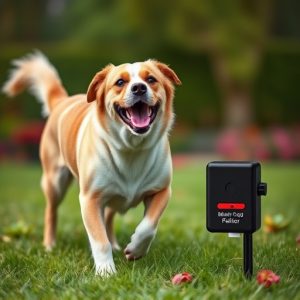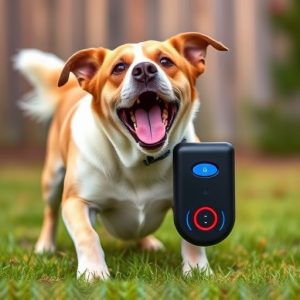Electronic Bark Control: Balancing Safety, Regulations, and Compassion
Electronic pet deterrents, like anti-barking devices, use positive reinforcement and negative punish…….
Electronic pet deterrents, like anti-barking devices, use positive reinforcement and negative punishment to teach pets alternative behaviors by interrupting excessive barking. Strictly regulated by safety standards to prevent harm, these tools emit sounds or mild shocks upon detection of excessive barking. Their effectiveness is supported by studies, but responsible usage requires consistent training and adherence to manufacturer guidelines and local Electronic Pet Deterrent Safety Regulations. Compliance with these regulations, along with open communication with neighbors, promotes peaceful coexistence between pets and communities, fostering harmonious living environments.
In many neighborhoods, excessive dog barking poses a persistent challenge, impacting quality of life. An increasingly popular solution is the electronic pet deterrent, designed to mitigate barking without causing harm. This article explores the effectiveness and safety of these devices, delving into their technological mechanisms and how they adhere to regulatory frameworks. We also discuss responsible usage practices for dog owners and community relations, emphasizing a balanced approach that combines technology with compassion. Understanding Electronic Pet Deterrent Safety Regulations is key to ensuring peaceful coexistence for both pets and people.
- Understanding Electronic Pet Deterrents: How They Work and Their Efficacy
- Regulatory Framework: Ensuring Safe and Effective Use of Anti-Barking Devices
- Integrating Technology with Compassion: Best Practices for Dog Owners and Neighborhood Relations
Understanding Electronic Pet Deterrents: How They Work and Their Efficacy
Electronic pet deterrents, often called anti-barking devices or pet training aids, utilize various technological methods to discourage unwanted behaviors in animals, primarily barking in dogs’ cases. These devices operate on the principle of positive reinforcement and negative punishment, aiming to teach pets alternative behaviors while minimizing their barking. When a dog barks excessively, the device emits a sound or mild shock designed to interrupt the behavior pattern. Over time, the pet learns to associate barking with this unpleasant stimulus, encouraging them to bark less.
The safety and efficacy of electronic pet deterrents are subject to regulatory scrutiny, ensuring they meet specific standards for animal welfare. These regulations govern the intensity of shocks, sound levels, and other factors to prevent any potential harm or discomfort to pets. While many studies support their effectiveness in reducing barking, it’s essential to use them responsibly and follow manufacturer guidelines. Proper training and consistent usage are crucial to ensure these devices work as intended without causing unnecessary stress or injury to the animal.
Regulatory Framework: Ensuring Safe and Effective Use of Anti-Barking Devices
The safe and effective use of anti-barking devices is heavily regulated to protect both pets and residents within a community. Local, state, or national laws often dictate the type of technology permitted, its deployment, and response thresholds. Electronic pet deterrents, such as those that emit ultrasonic sounds or spray a mild air scent, must adhere to strict safety guidelines. These regulations ensure these devices don’t cause physical harm to dogs or other animals, while also preventing false triggers that could lead to unnecessary distress for both pets and owners.
Compliance with Electronic Pet Deterrent Safety Regulations is crucial for responsible dog ownership. Homeowners or property managers installing anti-barking devices should carefully review the legal framework to select products that align with local standards. This process involves understanding not only what’s allowed but also how these devices are meant to be used responsibly, thereby fostering a harmonious environment where pets can live peacefully alongside their neighbors.
Integrating Technology with Compassion: Best Practices for Dog Owners and Neighborhood Relations
Integrating technology with compassion is a best practice for dog owners aiming to address barking issues while maintaining harmonious relationships within the neighborhood. Modern electronic pet deterrents, such as bark collars, offer advanced solutions designed to safely correct unwanted canine behavior. However, responsible usage requires adherence to safety regulations and ethical considerations. Dog owners should carefully select devices approved by relevant authorities, ensuring they meet specific safety standards, like those set forth in Electronic Pet Deterrent Safety Regulations.
Moreover, open communication with neighbors is vital. By discussing the issue proactively and exploring collaborative solutions, dog owners can foster a sense of community. This might involve implementing training programs or scheduling regular check-ins to monitor progress. Such an approach not only addresses barking concerns but also strengthens neighborhood bonds, creating a more harmonious living environment for everyone.
In light of the above discussions, it’s clear that electronic pet deterrents, particularly anti-barking devices, offer a potential solution for managing canine noise in neighborhoods. However, their safe and effective use requires adherence to stringent safety regulations. By integrating technology with compassion, dog owners can address barking issues while fostering positive relationships within the community. Understanding how these devices work, navigating regulatory frameworks, and adopting best practices are essential steps towards creating peaceful coexistence between pets and neighbors.


